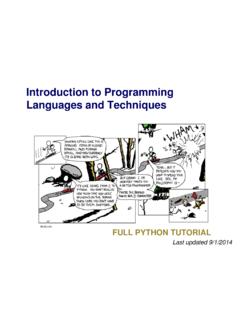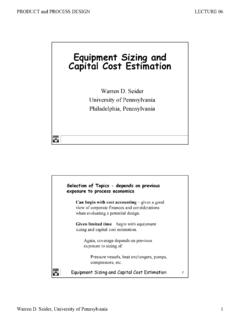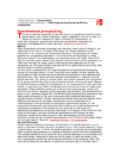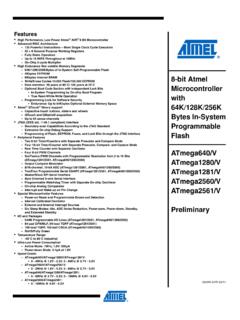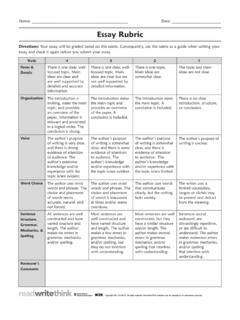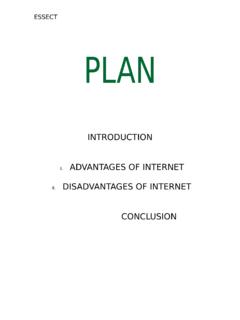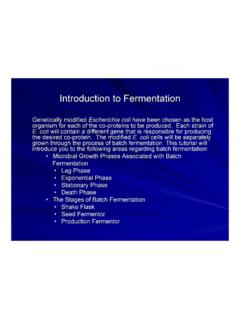Transcription of Turing Machines: An Introduction
1 CIT 596 Theory of Computation 1. Turing Machines: An Introduction We have seen several abstract models of computing devices: Deterministic Finite Automata, Nondeterministic Finite Automata, Non- deterministic Finite Automata with -Transitions, Pushdown Automata, and Deterministic Pushdown Automata. However, none of the above seem to be as powerful as a real com- puter, right? We now turn our attention to a much more powerful abstract model of a computing device: a Turing machine . This model is believed to do everything that a real computer can do.
2 C Marcelo Siqueira Spring 2005.. CIT 596 Theory of Computation 2. Turing Machines: An Introduction A Turing machine is somewhat similar to a finite automaton, but there are important differences: 1. A Turing machine can both write on the tape and read from it. 2. The read-write head can move both to the left and to the right. 3. The tape is infinite. 4. The special states for rejecting and accepting take immediate effect. c Marcelo Siqueira Spring 2005.. CIT 596 Theory of Computation 3. Turing Machines: An Introduction Formally, a Turing machine is a 7-tuple, (Q, , , , q0, qaccept, qreject), where Q is the (finite) set of states, is the input alphabet such that does not contain the special blank symbol t, is the tape alphabet such that t and , : Q Q {L, R}.
3 Is the transition function, q0 Q is the start state, qaccept Q is the accept state, and qreject Q is the reject state, where qaccept 6= qreject. The heart of a Turing machine is its transition function , as it tells us how the machine gets from one configuration to another. A Turing ma- chine configuration is entirely described by its current state, the current tape contents, and the current head location. c Marcelo Siqueira Spring 2005.. CIT 596 Theory of Computation 4. Turing Machines: An Introduction For a state q and two strings u and v over the tape alphabet , we write u q v for the configuration where the current state is q, the current tape contents is uv, and the current head location is the first symbol of v.
4 For instance, 1011 q7 0111. represents the configuration when the tape is 10110111, the current state is q7, and the head is currently on the second 0 of 10110111. from left to right. We say that configuration C1 yields configuration C2 if the Turing ma- chine can legally go from C1 to C2 is a single step. This notion can be formalized via the transition function. c Marcelo Siqueira Spring 2005.. CIT 596 Theory of Computation 5. Turing Machines: An Introduction Let a, b, and c be symbols of , let u and v be strings over , and let qi and qj be any two states (not necessarily distinct) in Q.
5 Then, we say that ua qi bv yields u qj acv if in the transition function (qi, b) = (qj , c, L). That handles the case where the Turing machine moves leftward. For a rightward move, we say that ua qi bv yields uac qj v if in the transition function (qi, b) = (qj , c, R). c Marcelo Siqueira Spring 2005.. CIT 596 Theory of Computation 6. Turing Machines: An Introduction A special case occurs when the head is at the left-hand end of the con- figuration. For the left-hand end, the configuration qi bv yields qj cv if the transition is left moving ( , the head does not move past the left-hand end), and it yields c qj v for the right moving transition.
6 For the right-hand end, the configuration ua qi is equivalent to ua qi t, as we assume that blanks follow the part of the tape represented in the configuration. The start configuration of a Turing machine on input w is the configu- ration q0 w, which indicates that the machine is in the start state q0 with its head at the leftmost position on the tape. c Marcelo Siqueira Spring 2005.. CIT 596 Theory of Computation 7. Turing Machines: An Introduction An accepting configuration is a configuration in which the state is the accept state.
7 A rejecting configuration is a configuration in which the state is the reject state. Accepting and rejecting configurations are halting configurations and accordingly do not yield further configurations. A Turing machine M accepts input w if a sequence C1, C2, .. , Ck of configurations exists such that C1 is the start configuration of M , Ci yields Ci+1, for all 1 i k 1, and Ck is an accepting configura- tion. The set of strings that M accepts is the language of M , denoted L(M ). c Marcelo Siqueira Spring 2005.
8 CIT 596 Theory of Computation 8. Turing Machines: An Introduction Let us use the blackboard to design a Turing machine that accepts the language L = {wcw | w {0, 1} }. Informally, our machine accepts L by executing the following algorithm: (1) Scan the tape from left to right to make sure the input string has exactly one symbol c. (2) Zig-zag across the tape to corresponding po- sitions on either side of c to check on whether these positions contain the same symbol. If they do not, reject. Cross off symbols as they are checked to keep track of which symbols correspond.
9 (3) When all symbols to the left of c have been crossed off, check for any remaining symbols to the right of c. If any symbols remain, reject; otherwise ac- cept. c Marcelo Siqueira Spring 2005.. CIT 596 Theory of Computation 9. Turing Machines: An Introduction Our Turing machine has 16 states, one of which is the accept state and another one is the reject state. The input alphabet is = {0, 1, c}. The tape alphabet is = {0, 1, c, X, t}. We write the symbol X on the tape to represent the action of crossing off an input symbol.
10 Let us use the black board to draw a diagram for our Turing machine . c Marcelo Siqueira Spring 2005.. CIT 596 Theory of Computation 10. Turing Machines: An Introduction We say that a language is recursively enumerable if it is accepted by some Turing machine . For instance, the language L = {wcw | w {0, 1} } is recursively enumerable. When a Turing machine starts, there are three possible outcomes: The machine may accept, reject, or loop. By loop, we mean that the machine simply does not halt. A Turing machine can fail to accept an input string by entering the qreject state and rejecting, or by looping.
